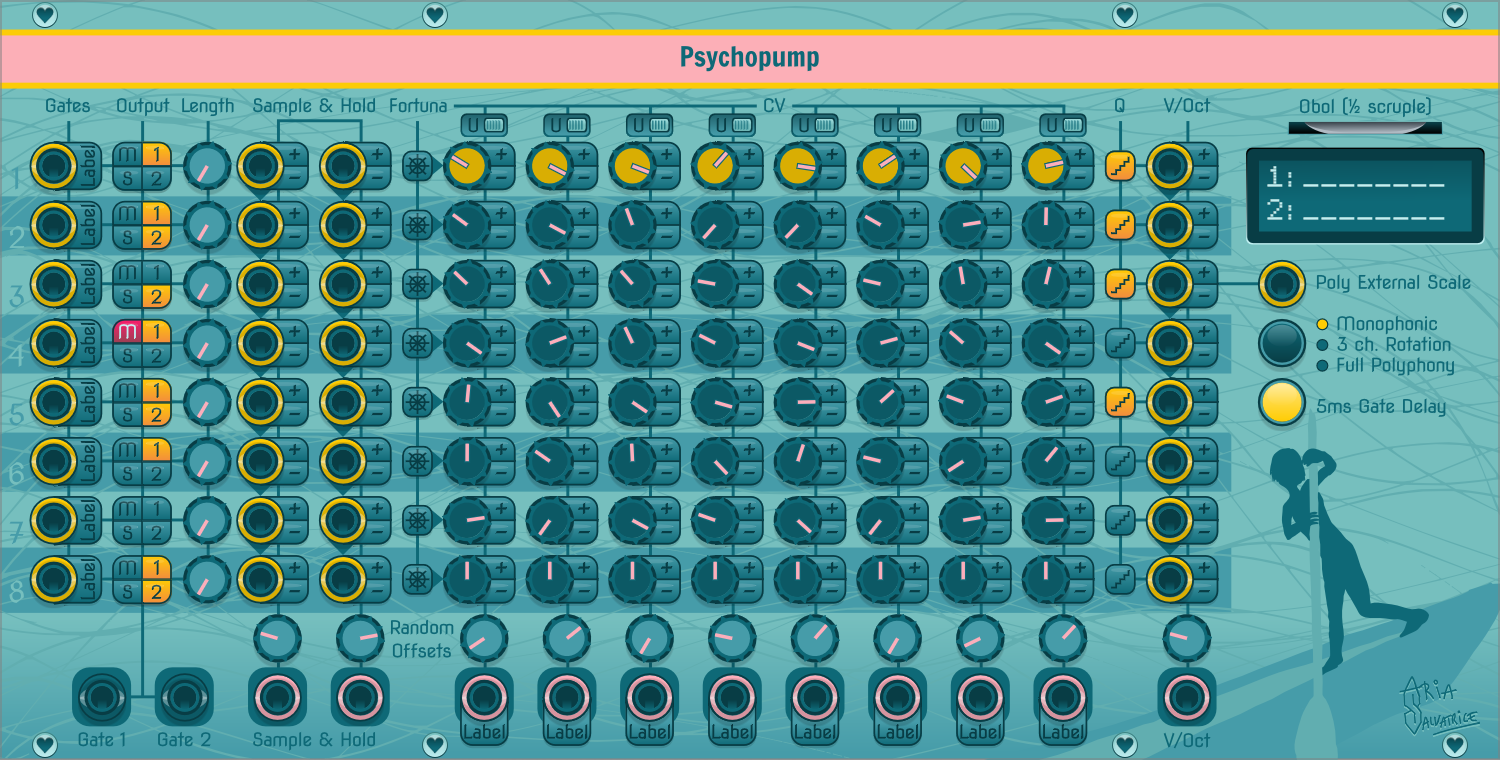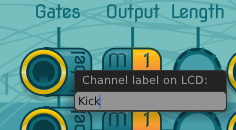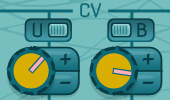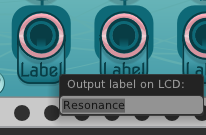
Psychopump
Send your beats straight to Hades
The big idea of Psychopump is simple: send gates to any of its 8 channels, it outputs the corresponding CV preset.
Why you would want to use it is more complex: it doesn't pair well with everything.
It was initially created to conserve CPU when using PSI OP, a fun FM drum module capable of a wide range of sounds, and like many oscillators, too CPU-hungry to use one separate instance per drum sound.
But Psychopump is not just about saving CPU, it can do much more.
Getting started
Let's make a little patch first. You will need a module that can produce gates, such as a clock or just some Pokies, and a module that can produce a variety of sounds when you send it gates and modulation. Can't think of any? Try out Hora Hi-Hat.

On a freshly initialized module, patch in a gate to the Gate 1 input.

Patch the Gate 1 output to the gate/trigger input of your sound-producing module.

Patch the first CV output to a modulation input of your sound-producing module.

Turn the knob that intersects the Gate 1 input and the first CV output.
You'll know you've found the right knob if the LCD says "Gate 1 Knob 1" when you operate it.
Send gates to the Gate 1 input: you'll see they are forwarded to the Gate 1 output, while the first CV output sends a snapshot of its value at the time it received a gate.

Now, patch in a second gate to the Gate 2 input, program its corresponding first knob differently, and listen what happens when you send gates to it.

Increase the random offset of the column of the first CV output. Simply moving the knob won't do anything, it's normal.

Click the + (Plus) and - (Minus) buttons next to the knobs you have previously operated: the random offset is now applied on each gate received.
That's it, that's the core of what Psychopump does for you. It's not meant too make a previously impossible workflow possible, it's meant to make it convenient, inspiring to program, and easy to perform.
Protip for cool kids only
Because Charon requires a payment of one obol to cross the river Styx, you will find such a coin factory-inserted in your module.
While the coin receptacle is not user-serviceable, a popular third-party mod for Psychopump you will find documented on the Internet entails enlarging the coin receptacle with a rotary tool, such that you can deposit a stack of six mon, allowing your CV and gates to cross the Sanzu river and reach Buddhist hell instead.
Before considering modding, please understand that any mod applied to any Aria Salvatrice Signature Series module voids its warranty, making it no longer eligible to have its bugs reported on Github.
Gates processing

The 8 Gate inputs accept gates or triggers. In default Monophonic operation, when a gate is received, it makes the corresponding channel active, whether it's routed or not.
In case of simultaneous gates, the highest numbered inputs have the highest priority. There are multiple ways of making creative use of that behavior.

The two Gate outputs pass through the received gates, depending how they're routed.

By clicking the Label button, you can name the corresponding gate.

When you operate knobs, the names show up on the LCD.

Those four buttons control whether the gates are output.
The Mute and Solo button work the same way they do on a mixer. They mute the input rather than the output, so when muted, receiving a gate won't activate a channel.
The 1 and 2 buttons let you choose to which output to route the gate.
Even if a gate is not routed to an output, receiving it will still make the channel active.

The Length knob allows you to change the duration of the received input. You can turn a long gate into a short trigger, or the other way around. By keeping the knob all the way to the left, gates are passed as-is without change.
No matter how long you make the gates, they will still retrigger properly, by insterting one millisecond of silence when retriggered.
Protip for cool kids only
If your beats are hot enough, instead of paddling, you might start to perceive Charon as pole dancing.
Sample & Hold

Each channel has a pair of Sample & Hold inputs. The value is sampled when a trigger is received on that channel.
If no cable is patched in an input, it tries to read the inputs above it until a cable is found.

A Random Offset from 0V up to the value of the Random Offset knob can be added or subtracted from the Sample & Hold inputs by enabling the corresponding + (Plus) and - (Minus) button. When both are enabled, if effectively doubles the range of the randomness.
Random offsets can be used to create crazy modulations, but they also work great when they're subdued, for example by applying subtle variations to drum hits to give them a more analog character and reduce the machine gun effect.
CV section
Each channel has 8 programmable knobs, with optional Random Offsets working the same as described just above.

In default Monophonic operation, the value of each knob in the active channel is sent to its corresponding CV output when a gate is received.
If you move the knobs after receiving a gate, it won't be reflected in the outputs before another gate is received.

Knobs can be either Unipolar (0V ~ 10V) or Bipolar (-5V ~ 5V) depending on the position of the rocker switch at the top of the column. By default they're Unipolar.

You can give the Rota Fortunae a spin to randomize the 8 knobs to its right. It's much more useful to randomize a single channel than the entire device.
If you don't like the results, you can Undo them.

By clicking the Label button, you can name the corresponding output.

When you operate knobs, the names show up on the LCD.
Pitch

Each channel's V/Oct input works like the Sample & Hold by default, but optional features make it uniquely suited for pitch signals.


When the Quantize button is enabled, the pitch for that channel gets quantized to the scale received in the Poly External Scale input, which can be set by modules such as QQQQ.
If there's no Poly External Scale patched, the signal is quantized to the chromatic scale instead - that is, to the closest semitone.
Protip for cool kids only
To save CPU and simplify timing operations, Psychopump operates only once per millisecond.
Nonetheless, it has been proven to produce dope bangers up to 666 BPM.
Polyphony

There are three Polyphony Modes you can select by pressing this button: Monophonic, 3 Channel Rotation, and Full Polyphony.
By default, the device is in Monophonic mode, which is the easiest one to program. It works well with modules such as PSI OP, as the constant retriggering has an interesting sonic character, and also with monophonic modules capable of sustaining the previous decaying voice, such as Mutable Instruments Rings, available as Resonator.
In 3 Channel Rotation mode, the 3 most recently triggered channels are output, allowing you to have multiple voices at once, without reserving 8 voices. It's good for polyphonic modules that consume CPU time even when a voice is idle, such as Palette.
With Full Polyphony, all the channels are output all the time, in order. There's as many channels as the last Gate input connected.
Delay

You can optionally enable a 5ms Gate Delay. As the name implies, it only delays the gates, not the CV.
In general, in a virtual modular synth, it doesn't really matter if the gates are received a few samples before the modulation arrives: it's so fast, you won't hear any glitch. But in some cases, modules snapshot their value on trigger, and in that case, it's crucial the gate arrives no sooner than the CV.
If you process Psychopump's CV output before it reaches its destination, it will add at least one sample of delay, causing such a desync. Enabling the 5ms Gate Delay ensures the gate will always arrive second.
You can't configure the duration. If it's too long or too short for you, just patch the delay of your choice. It's just meant as a quick fix button if you notice something's wrong.